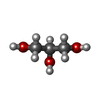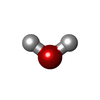[English] 日本語
 Yorodumi
Yorodumi- PDB-9q3h: GspB Siglec domain bound to sialyl T antigen linked to serine-FMOC -
+ Open data
Open data
- Basic information
Basic information
| Entry | Database: PDB / ID: 9q3h | ||||||
|---|---|---|---|---|---|---|---|
| Title | GspB Siglec domain bound to sialyl T antigen linked to serine-FMOC | ||||||
 Components Components | Platelet binding protein GspB | ||||||
 Keywords Keywords | SUGAR BINDING PROTEIN / SLBR | ||||||
| Function / homology |  Function and homology information Function and homology information | ||||||
| Biological species |  Streptococcus (bacteria) Streptococcus (bacteria) | ||||||
| Method |  X-RAY DIFFRACTION / X-RAY DIFFRACTION /  SYNCHROTRON / SYNCHROTRON /  MOLECULAR REPLACEMENT / Resolution: 1.89 Å MOLECULAR REPLACEMENT / Resolution: 1.89 Å | ||||||
 Authors Authors | Morrison, K.M. / Martin, K.A. / Iverson, T.M. | ||||||
| Funding support |  United States, 1items United States, 1items
| ||||||
 Citation Citation |  Journal: To Be Published Journal: To Be PublishedTitle: GspB Siglec domain bound to sialyl T antigen linked to serine-FMOC Authors: Morrison, K.M. / Martin, K.A. / Iverson, T.M. | ||||||
| History |
|
- Structure visualization
Structure visualization
| Structure viewer | Molecule:  Molmil Molmil Jmol/JSmol Jmol/JSmol |
|---|
- Downloads & links
Downloads & links
- Download
Download
| PDBx/mmCIF format |  9q3h.cif.gz 9q3h.cif.gz | 134.9 KB | Display |  PDBx/mmCIF format PDBx/mmCIF format |
|---|---|---|---|---|
| PDB format |  pdb9q3h.ent.gz pdb9q3h.ent.gz | 85.1 KB | Display |  PDB format PDB format |
| PDBx/mmJSON format |  9q3h.json.gz 9q3h.json.gz | Tree view |  PDBx/mmJSON format PDBx/mmJSON format | |
| Others |  Other downloads Other downloads |
-Validation report
| Arichive directory |  https://data.pdbj.org/pub/pdb/validation_reports/q3/9q3h https://data.pdbj.org/pub/pdb/validation_reports/q3/9q3h ftp://data.pdbj.org/pub/pdb/validation_reports/q3/9q3h ftp://data.pdbj.org/pub/pdb/validation_reports/q3/9q3h | HTTPS FTP |
|---|
-Related structure data
| Similar structure data | Similarity search - Function & homology  F&H Search F&H Search |
|---|---|
| Experimental dataset #1 | Data reference:  10.15785/SBGRID/1193 / Data set type: diffraction image data 10.15785/SBGRID/1193 / Data set type: diffraction image data |
- Links
Links
- Assembly
Assembly
| Deposited unit | 
| ||||||||||||
|---|---|---|---|---|---|---|---|---|---|---|---|---|---|
| 1 |
| ||||||||||||
| Unit cell |
|
- Components
Components
-Protein / Sugars , 2 types, 4 molecules AB
| #1: Protein | Mass: 13952.391 Da / Num. of mol.: 2 Source method: isolated from a genetically manipulated source Source: (gene. exp.)  Streptococcus (bacteria) / Gene: gspB / Production host: Streptococcus (bacteria) / Gene: gspB / Production host:  #2: Polysaccharide | Type: oligosaccharide / Mass: 674.604 Da / Num. of mol.: 2 Source method: isolated from a genetically manipulated source |
|---|
-Non-polymers , 5 types, 141 molecules 






| #3: Chemical | | #4: Chemical | Mass: 258.700 Da / Num. of mol.: 2 / Source method: obtained synthetically / Formula: C15H11ClO2 / Feature type: SUBJECT OF INVESTIGATION #5: Chemical | #6: Chemical | #7: Water | ChemComp-HOH / | |
|---|
-Details
| Has ligand of interest | Y |
|---|---|
| Has protein modification | N |
-Experimental details
-Experiment
| Experiment | Method:  X-RAY DIFFRACTION / Number of used crystals: 1 X-RAY DIFFRACTION / Number of used crystals: 1 |
|---|
- Sample preparation
Sample preparation
| Crystal | Density Matthews: 1.96 Å3/Da / Density % sol: 37.24 % |
|---|---|
| Crystal grow | Temperature: 296 K / Method: vapor diffusion, hanging drop Details: 1 uL protein (22 mg/ml preincubated in 10 mM sTa-Ser-FMOC) and 2 uL reservoir solution over 600 uL reservoir solution ( 0.2 M MgCl2, 0.1 M Tris-HCl, pH 8.5, 50% PEG 4000). Crystals were ...Details: 1 uL protein (22 mg/ml preincubated in 10 mM sTa-Ser-FMOC) and 2 uL reservoir solution over 600 uL reservoir solution ( 0.2 M MgCl2, 0.1 M Tris-HCl, pH 8.5, 50% PEG 4000). Crystals were cryoprotected in 25% (v/v) glycerol and flash-cooled in liquid nitrogen. protein was in 18 mM Tris-HCl, pH 7.5, and 200 mM NaCl. |
-Data collection
| Diffraction | Mean temperature: 100 K / Serial crystal experiment: N |
|---|---|
| Diffraction source | Source:  SYNCHROTRON / Site: SYNCHROTRON / Site:  ESRF ESRF  / Beamline: BM07 / Wavelength: 0.97951 Å / Beamline: BM07 / Wavelength: 0.97951 Å |
| Detector | Type: DECTRIS PILATUS 6M / Detector: PIXEL / Date: Aug 1, 2023 |
| Radiation | Protocol: SINGLE WAVELENGTH / Monochromatic (M) / Laue (L): M / Scattering type: x-ray |
| Radiation wavelength | Wavelength: 0.97951 Å / Relative weight: 1 |
| Reflection | Resolution: 1.89→23.1 Å / Num. obs: 14353 / % possible obs: 86 % / Redundancy: 3.1 % / Biso Wilson estimate: 23.52 Å2 / CC1/2: 0.999 / Rmerge(I) obs: 0.184 / Rsym value: 0.065 / Net I/σ(I): 26.2 |
| Reflection shell | Resolution: 1.89→1.93 Å / Num. unique obs: 2360 / CC1/2: 0.981 / Rsym value: 0.218 / % possible all: 63.2 |
- Processing
Processing
| Software |
| ||||||||||||||||||||||||||||||||||||||||||
|---|---|---|---|---|---|---|---|---|---|---|---|---|---|---|---|---|---|---|---|---|---|---|---|---|---|---|---|---|---|---|---|---|---|---|---|---|---|---|---|---|---|---|---|
| Refinement | Method to determine structure:  MOLECULAR REPLACEMENT / Resolution: 1.89→23.1 Å / SU ML: 0.1843 / Cross valid method: FREE R-VALUE / σ(F): 2.05 / Phase error: 23.6279 MOLECULAR REPLACEMENT / Resolution: 1.89→23.1 Å / SU ML: 0.1843 / Cross valid method: FREE R-VALUE / σ(F): 2.05 / Phase error: 23.6279 Stereochemistry target values: GeoStd + Monomer Library + CDL v1.2
| ||||||||||||||||||||||||||||||||||||||||||
| Solvent computation | Shrinkage radii: 0.9 Å / VDW probe radii: 1.1 Å / Solvent model: FLAT BULK SOLVENT MODEL | ||||||||||||||||||||||||||||||||||||||||||
| Displacement parameters | Biso mean: 40.12 Å2 | ||||||||||||||||||||||||||||||||||||||||||
| Refinement step | Cycle: LAST / Resolution: 1.89→23.1 Å
| ||||||||||||||||||||||||||||||||||||||||||
| Refine LS restraints |
| ||||||||||||||||||||||||||||||||||||||||||
| LS refinement shell |
|
 Movie
Movie Controller
Controller


 PDBj
PDBj



